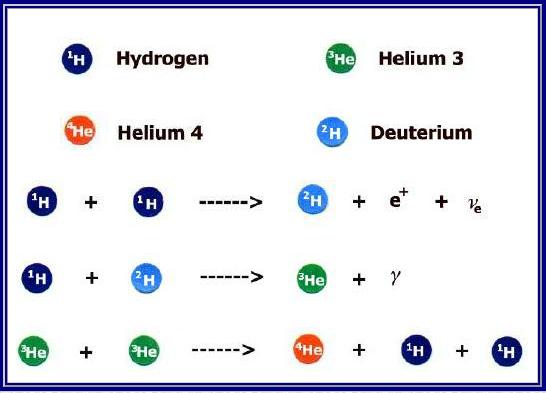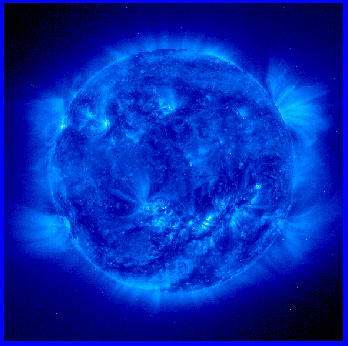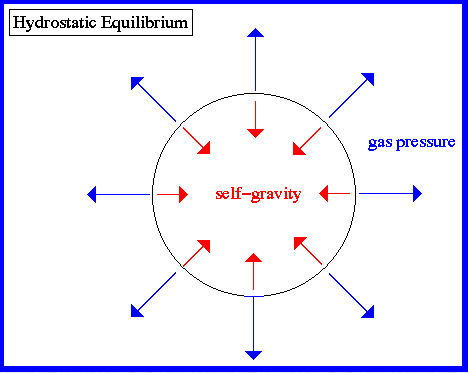 Lesson 1:
Lesson 1:
 Ecology of the System
Ecology of the System
|
 1.4
1.4
 The Nuclear Generator
The Nuclear Generator

|

Figure 1.4.1 Internal structure of the Sun
|
Two thousand and five hundred years ago the Geek philosopher Anaxagoras
claimed that the Sun is not a god (who adjusts energy output to human
needs) but a huge ball of fire (which doesn't particularly care about
humans). This idea did not go over well, and resulted in exile for the
philosopher, after a proper trial for impiety.
What kind of fire is burning on the Sun? And what keeps it burning
steady?
The power generator in the Sun is in its center, buried deeply within
it. It is called "the core", with a radius close to one fourth of that
of the star. In the core, pressures and temperatures are high enough to
force fusion, that is, nuclear reactions whereby some nuclei merge to
make others. It is the type of reaction that powers a hydrogen bomb. The
most important reaction within the core of the Sun is the process called
the "proton-proton chain."

|
Figure 1.4.2 The proton-proton chain.This is the principle
fusion reaction in the Sun. Mass, in the form of hydrogen
atoms, is converted to energy as described by Einstein's
formula
E = mc2.
This energy is then transported to the solar surface and
emitted as light or ejected as high-energy particles.
|
In the proton-proton chain reaction, hydrogen nuclei are converted to
helium nuclei through a number of intermediates. The reactions produce
high-energy photons (gamma rays) which move through the "radiative
layer" surrounding the core. This layer takes up 60 percent of the
radius of the Sun. It takes a million years for energy to get through
this layer into the "convective layer", because the photons are
constantly intercepted, absorbed and re-emitted. In the core, the helium
nuclei make up 62% of the mass (the rest is still hydrogen). The
radiative and convective layers have about 72% hydrogen, 26% helium, and
2% heavier elements (by mass).
By the time the energy reaches the surface of the Sun, things have
cooled down to 6000 degrees Kelvin, a temperature that corresponds to
the sunlight we see. By now most of the hydrogen is in the atomic state
and the density of the gas is low, similar to that of the gas in neon
lights. The energy emitted from the hot surface, on average, is near 230
million watts per square meter. (On Earth's surface, we typically get
about a millionth of that, to warm us.)

|

Figure 1.4.3 The solar surface showing active
regions and magnetic loops.
|
Nuclear fusion, the source of all the energy so generously radiated by
the Sun, does two things: it converts hydrogen into helium (or rather,
makes helium nuclei from protons) and it converts mass to energy.
The mass-to-energy conversion is described by Einstein's famous
equation: E = mc2, or, in words, energy equals mass times the square
of the velocity of light. Because the velocity of light is a very large
number, this equation says that lots of energy can be gained from using
up a modest amount of mass.
The energy created by the fusion processes within the core of the Sun
(or any other star) exerts an outward pressure. Unless contained, such
pressure would produce an explosion (as happens in the hydrogen bomb, on
a much smaller scale). The inward pressure that keeps a star from
exploding is the gravitational attraction of the gas mantle surrounding
the core which is most of the volume of the Sun.

|
Figure 1.4.4 The pressure of the energy generated in the solar
core pushes outward and would cause the Sun to expand if it
were not exactly balanced by the gravitational pressure of the
Sun's outer layers.
|
The outward pressure from the fusion reactions keeps the stars from
collapsing. The inward pressure from gravitation keeps the stars from
exploding. If the fusion reactions in the core become too weak, a star
can and does collapse. Such collapse can provide new conditions in a
core which result in new types of fusion reactions, so that expansion
follows. If fusion reactions in the core become too strong, a star can
and does explode. Such events can be observed. When a star explodes it
shines with extreme brightness for a while; it turns from unnoticed
to a "new" star, a "supernova". Stars, like Sol, where inward pressure and
outward pressure is nicely balanced, fluctuate but little in brightness
and give off a steady stream of energy. The balance is achieved by
self-regulation: a slight decrease in fusion energy would result in
contraction which would heat up the core and increase fusion rate, and
vice versa. Other stars, where the balance is not so well tuned, pulsate
noticeably. Living on a planet circling a pulsating star presumably
would be difficult or impossible.

|

Figure 1.4.5 The Crab Nebula. This is remnant of a supernova
that occurred in the year 1054. When nuclear reactions in
the core of a star no longer generate enough pressure to
offset its weight, the star may explode, as happened here.
|
|
Thus, the reason that the Sun neither expands (from the ongoing
fusion reactions within) nor collapses (from its own weight) is that the two
forces keep the balance. In the distant future, when this balance is
disturbed because most of the hydrogen is used up, the Sun will expand.
This will be the end of the solar system as we know it.
Thus, on the whole, our star shines with a steady light, which is good
for Life. However, it has changed its output over geologic time (we will
take up this problem when discussing the "faint sun paradox"). Also, it
varies a bit on a number of cycles. The most obvious manifestation of
this is the so-called "sunspot cycle" which describes periodic changes
in the abundance of spots on the face of Sol. The abundance of spots is
related to the brightness of the Sun (more spots, more brightness). The
variation is less than 1 percent, and the mechanisms are poorly
understood. It has to do with changes in the magnetic field of the Sun
and with convection within the outer layer of our star (not with
processes in the core). Sunspot activity is closely in phase with
ejection of solar plasma (protons mainly) and the ensuing atmospheric
fireworks in the polar regions of Earth called "aurora".

|

Figure 1.4.6 The Aurora Borealis Charged particles
from the solar wind collide with atoms in the Earth's
atmosphere to produce the "Northern Lights".
|
|
|





















